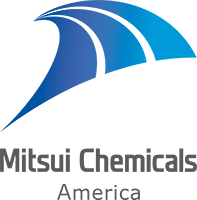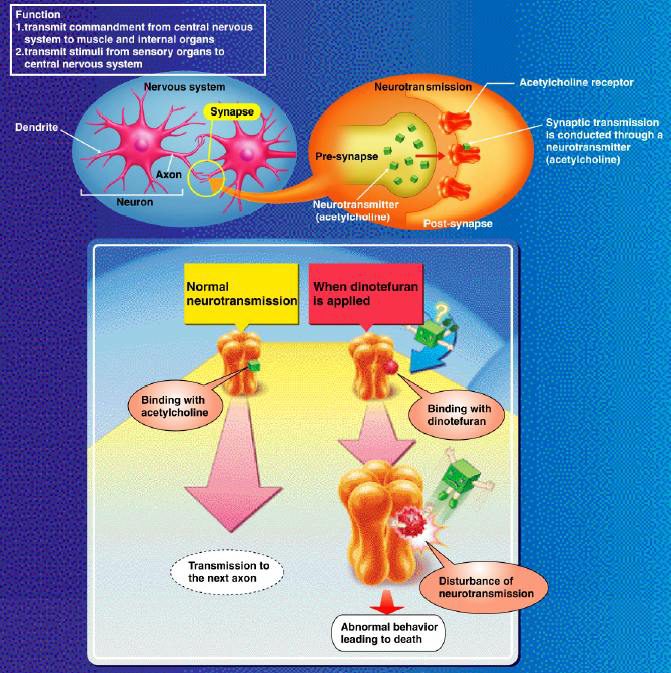Highly systemic furanicotinyl insecticide for crop and pest control.
Dinotefuran
Dinotefuran
Applications detail
Applications
- Introduction
- Characteristics
- Field Performance
Dinotefuran is a new furanicotinyl insecticide which represents the third generation of neonicotinoid group. Dinotefuran, which was developed by Mitsui Chemicals, Inc., was registered in Japan April 24, 2002 and the registration has been submitted to the Environment Protection Agency (EPA) in the USA. Dinotefuran was granted Organophosphorus Alternative and Reduced Risk Status by the EPA.
Physical & Chemicals Properties
| Code: | MTI-446 |
| Common Name: | Dinotefuran (ISO name) |
| Chemical Name: | (RS)-1-methyl-2-nitro-3-(tetrahydro-3-furylmethyl) guanidine |
| Chemical Structure: |

|
| Melting Point: | 107.5° C |
| Water Solubility: | 39.83 g/L |
Dinotefuran Precautions and Safety (old)
PRECAUTIONS
- Avoid contact with eyes, skin or clothing. When measuring and mixing the product, wear protective garment, waterproof gloves, protective mask and goggles, rubber boots, apron and hat. At spraying, wear protective garment, shoes and hat.
- Wash exposed skin thoroughly with soap and water after handling and application.
- Do not apply in a fish farm or in shrimp, prawn or crab pond/ nursery.
- This product is toxic to bees exposed to direct treatment or residues on blooming crops or weeds. Do not apply this product or allow it to drift to blooming crops or weeds if bees are visiting the treatment area.
- This product is toxic to silkworms exposed to direct treatment or residues on mulberry leaves. Do not apply this product or allow it to drift to mulberry trees.
STORAGE AND DISPOSAL
- Store in a closed, cool, dry place and away from fire and sunshine.
- Store in original container in safe place and away from reach of children.
- Burn or bury empty containers in an isolated area according to local rules and away from sources of water. Do not reuse.
FIRST AID
SKIN CONTACT: Immediately wash with soap and water.
EYE SPLASHES: Flush eyes immediately with steady running water for at least 15 minutes. Get medical attention immediately.
IF INHALED: Remove victim from area of exposure and move to fresh air. Get medical attention.
IF SWALLOWED: DO NOT induce vomiting. Give one or two glasses of water and GET MEDICAL ATTENTION IMMEDIATELY. Never give anything by mouth to an unconscious person.
| ALWAYS FOLLOW THE LABEL INSTRUCTIONS BEFORE USE |
Related Products
High Systemicity
- Readily absorbed and translocated into plants.
- Can be applied on foliage, soil, nursery boxes and paddy water by spray, drench, broadcast and planting hole application with various types of formulations.

Translaminar Action
- Dinotefuran has a translaminar action to exhibit insecticidal efficacy on abaxial surface of leaf when applied at adaxial side.

Low Resurgence Possibility
- Since Dinotefuran has almost no efficacy on predatory mite, resurgence probability is very low.

Broad Spectrum
Effective on:
- Sucking insects such as aphids, plant bugs, leafhoppers and mealybugs.
- Coleoptera species such as weevil, Colorado potato beetle and flea beetle.
- Diptera species such as leafminer fly.
- Certain Lepidoptera species such as fruit moths and leafminers.
- Other species such as thrips, grasshoppers and fire ants.

Rain Fastness
Dinotefuran can work well even after rainfall at 3 hours after application.

Residual Efficacy
Dinotefuran can protect crops from insects for a long period thanks to its excellent activity, high systemicity and proper stability in the environment.

Low Toxicity
Toxicity against mammalian, birds, and aquatic organism species is very low.
Low Phytotoxicity
No phytotoxicity has been reported at the recommended dosage.
Rice
Rice Leaf Bug

- Plant: Rice
- Pest: Rice leaf bug
- Application: Foliar Application (2 times, Jul 25 and Aug. 2)
- Evaluation: Rate of pecky rice (= damaged grains) was examined 19 days after the last application
Results: Dinotefuran exhibited efficacy superior to Silafluofen.
Plant Hoppers

- Plant: Rice
- Pest: Brown rice planthopper (Nilaparvata lugens), Small brown planthopper (Laodelphax striatellus) and Whitebacked rice planthopper (Sogatella furcifera)
- Application: Foliar Application (July 30)
- Evaluation: Number of insects (adult + nymph) were examined 21 days after application
Results: Dinotefuran exhibited efficacy equivalent to etofenprox.
Rice Stem Borer

- Plant: Rice
- Pest: Rice stem borer (Chilo suppressalis)
- Application: Foliar Application
- Evaluation: Rate of damaged stems was examined 30 days after application
Results: Dinotefuran exhibited efficacy superior to cartap.
Cabbage
Diamondback Moth

- Plant: Cabbage
- Pest: Diamondback moth (Plutella xylostella)
- Application: Nursery box irrigation on the day of planting (Dinotefuran), Planting hole application (acetamiprid)
- Evaluation: Number of insects were examined 8, 14, and 21 days after application
Results: Dinotefuran exhibited efficacy equivalent to acetamiprid.
Leaf Lettuce
Aster Leafhopper

- Plant: Leaf lettuce
- Pest: Aster leafhopper (Macrosteles quadrilineatus)
- Application: Foliar Application (25 gallons per acre)
- Evaluation: Number of insects on 5 leaves from the center two rows were examined prior to, and 3, 7 and 14 days after application
Results: Dinotefuran exhibited efficacy superior to imidacloprid.
Sweet Pepper
Green Peach Aphid

- Plant: Sweet pepper
- Pest: Green peach aphid (Myzus persicae)
- Application: Foliar Application
- Evaluation: Number of insects per 10 leaves were examined prior to and 3, 7 and 14 days after application
Results: Dinotefuran exhibited efficacy equivalent to imidacloprid.
Tomato
Silverleaf Whitefly

- Plant: Tomato
- Pest: Silverleaf whitefly (Bemisia tabaci)
- Application: Foliar Application (2,500 l/ha)
- Evaluation: Number of insects were examined 14 days after application
Results: Dinotefuran exhibited efficacy equivalent to acetamiprid.
Cucumber
Silverleaf Whitefly

- Plant: Cucumber
- Pest: Silverleaf whitefly (Bemisia tabaci)
- Application: Foliar Application (3,500 l/ha)
- Evaluation: Number of insects on upper 5 leaves of 8 plants per plot were examined prior to, and 3, 7 and 14 days after application
Results: Dinotefuran exhibited efficacy superior to imidacloprid.
Watermelon
Cotton Aphid

- Plant: Watermelon
- Pest: Cotton aphid (Aphis gossypii)
- Application: Foliar Application
- Evaluation: Number of insects per 15 leaves were examined prior to, and 3, 7 and 14 days after application
Results: Dinotefuran exhibited efficacy superior to acetamiprid.
Celery
Sweetpotato Whitefly

- Plant: Celery
- Pest: Sweetpotato whitefly (Bemisia tabaci)
- Application: Soil shank with tractor-mounted soil injector to the root zone
- Evaluation: Number of adults on each leaf were examined prior to, and 3, 7, 14 and 21 days after application
Results: Dinotefuran at 300 g a.i./ha exhibited whitefly control that was equivalent to imidacloprid at the label rate.
Mango
Mango Leafhopper

- Plant: Mango
- Pest: Mango leafhopper (Idioscopus clypealis and i. niveosparus)
- Application: Foliar Application at a rate of 5 l /tree (3-4 m height trees)
- Evaluation: Number of insects per inflorescence were examined (20 inflorescence/ tree, 6 trees/ application)
Results: Dinotefuran gave excellent control effect against leafhoppers at the lowest dosage tested in this trial, 2.5g a.i./ h l, being superior to lamda-cyhalothrin at 1.25 a.i./ h.
Citrus
Japanese Mealybug

- Plant: Citrus
- Pest: Japanese mealybug (Planococcus kraunhiae)
- Application: Foliar Application (to drop off)
- Evaluation: Number of insects were examined 13 days after application
Results: Dinotefuran exhibited efficacy equivalent to DMTP.
Apple
Codling Moth

- Plant: Apple
- Pest: Codling moth (Cydia pomonella)
- Application: Foliar Application (250 ml / stem)
- Evaluation: Number of larvae were examined 10 days after application
Results: Dinotefuran exhibited efficacy superior to phosalone.
Peach
Peach Fruit Moth

- Plant: Peach
- Pest: Peach fruit moth (Carposina niponensis)
- Application: Foliar Application
- Evaluation: Rate of damaged fruit was examined
Results: Dinotefuran exhibited efficacy superior to chlorpyrifos.
Peach Leafminer

- Plant: Peach
- Pest: Peach leafminer (Lyonetia clerkella)
- Application: Foliar Application
- Evaluation: Number of insects per 30 branches were examined 20 days after application
Results: Dinotefuran exhibited efficacy superior to DMTP.
Potato
Colorado Potato Beetle

- Plant: Potato
- Pest: Colorado potato beetle (Leptinotarsa decemlineata)
- Application: Foliar Application
- Evaluation: Number of larvae per plant were examined prior to, and 2, 8 and 13 days after application
Results: Dinotefuran exhibited Colorado potato beetle control that was superior to deltamethrin.
Potato Leafhopper

- Plant: Potato
- Pest: Potato leafhopper (Empoasca fabae)
- Application: Foliar Application
- Evaluation: Number of insects per leaf were examined 35 days after application
Results: Dinotefuran exhibited potato leafhopper control that was superior to imidacloprid.
Cotton
Western Lygus Bug

- Plant: Cotton
- Pest: Western lygus bug (Lygus hesperus)
- Application: Foliar Application (50 gallons per acre, 4 times; Aug. 10, Aug. 24, Sept. 7 and Sept. 21)
- Evaluation: Number of insects were examined 14 days after the last application
Results: Dinotefuran at 50 and 100 g a.i./ha exhibited lygus control that was superior to imidacloprid.
Cotton Aphid

- Plant: Cotton
- Pest: Cotton aphid (Aphis gossypii)
- Application: Foliar Application (20 gallons per acre)
- Evaluation: Number of alive aphids on 10 terminal leaves were examined prior to, and 3, 7 and 14 days after application
Results: Dinotefuran at 50 and 100 g a.i./ha exhibited aphid control that was as effective as carbofuran at the label rate.
Turf
Southern Chafer Grub

- Plant: Bermudagrass
- Pest: Southern masked chafer (Cyclocephala immaculata)
- Application: Foliar Application (30 gallons per acre)
- Evaluation: Grub populations were estimated using a standard 4-inch cup cutter at 6-inch depths prior to, and 14, 28, 42, 56 and 70 days after application
Results: Dinotefuran at 560g a.i./ha exhibited Southern masked chafer control that was equivalent to imidacloprid at the label rate.
Sugarbeet
Flea Beetle

- Plant: Sugarbeet
- Pest: Flea beetle (Chaetocnema tibialis)
- Application: Seed dressing
- Evaluation: Sugarbeets were harvested, then damage from flea beetle was estimated from number of stings on the crops
Results: Dinotefuran exhibited inhibition of damage from Flea beetle that was superior to imidacloprid.
Dinotefuran Insecticidal Activity on Non-Crop Pests
Dinotefuran has insecticidal activity on various pests and can be used for wide variety of purpose. Examples of purpose and pest are shown.
| For Animal Health | For House Hold / For Pest Management Professionals |
|---|---|
|
|
The information contained in this website is, to the best of our knowledge, accurate and reliable, but all suggestions are made without warranty, either express or implied. The values relevant to properties or the like of the product stated herein were obtained using field test specimens prepared at official organizations in some countries and are not assumed to be identical to values obtained on the finished product manufactured by our customers and on our finished product tested by our customers in a different condition. Nothing herein shall be construed as permission or as recommendation for uses which infringe valid patents or as extending a license under valid patents. Because the conditions and methods of use on the part of our customers are beyond our control, Mitsui Chemicals, Inc. disclaims any liability incurred in connection with the use of our products.
Photo Images with © ZNK are the property of Zenkoku Noson Kyoiku Kyokai Publishing Co.Ltd.



